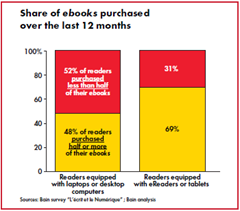 Publishing Perspectives reports on a new study (PDF file) commissioned from Bain & Co. by the Forum d’Avignon that suggests 15 to 20% of the developed world’s population could be using digital reading devices by 2015, and that digital formats may account for “20 to 28% of industry profits in the medium to long term.” The survey sample consisted of 3,000 people from several countries.
Publishing Perspectives reports on a new study (PDF file) commissioned from Bain & Co. by the Forum d’Avignon that suggests 15 to 20% of the developed world’s population could be using digital reading devices by 2015, and that digital formats may account for “20 to 28% of industry profits in the medium to long term.” The survey sample consisted of 3,000 people from several countries.
There are a number of interesting findings here, but I was drawn in particular to this paragraph from the Publishing Perspectives article:
The biggest obstacle to adopting a digital device, cited by 41% of respondents, is the unwillingness to abandon “the paper experience.” The second issue [is e-reader prices], which many consider still too high, though this is likely to diminish as the price of devices declines, a “psychological threshold.” Bain predicts that e-readers “could capture as much as a third of the market” for their ability to replicate the experience of reading on paper.
At the bottom of the chart, only 3% of those surveyed said that seeking advice from a bookseller is a significant barrier to their e-book adoption. Bad news for booksellers, perhaps.
The problem I find here is that neither the Publishing Perspectives article nor the original study document goes into any detail about what “the paper experience” really is. In what ways are e-book readers supposed to replicate “the experience of reading on paper”? Presenting black words on nearly-white backgrounds, like the Kindle? Or providing cute little page-turn animations like iBooks on the iPad? Smelling like a paper book?
 Here’s another interesting chart from the survey, showing the disparity between computers and e-readers when it comes to books purchased vs. downloaded for free. A significantly higher percentage of people who use e-readers or tablets purchase most of their e-books than those who just use computers. Not so much a surprise when you think about it, given how easy a lot of e-book readers make it to purchase books.
Here’s another interesting chart from the survey, showing the disparity between computers and e-readers when it comes to books purchased vs. downloaded for free. A significantly higher percentage of people who use e-readers or tablets purchase most of their e-books than those who just use computers. Not so much a surprise when you think about it, given how easy a lot of e-book readers make it to purchase books.
However, consumer willingness to purchase e-books does not translate to willingness to purchase e-newspapers. The report notes:
The press’s business model has already been disrupted. Regardless of device, consumers today expect ubiquitous, instantaneous and free information. Nearly 90 per cent of those we surveyed only read free news content online. For those with digital tablets, only 10 per cent say they would pay for news. Except for sub-segments like micropayments in South Korea, the demand for paid content seems to be confined to such areas as financial information, local news or investigative journalism. However, even those willing to pay say they would spend three times less for digital news than for the print version.
Bad news for Murdoch and others who are pushing paywalls. Though perhaps not so bad for those who can economically develop the sort of premium content that users would be willing to purchase.
There doesn’t seem to be much new here in general, but it is interesting to see some specific figures on key aspects of the e-book market. Perhaps this study will be useful to publishers and others in the book and e-book markets moving forward.

































I hate to cut in on such a ‘detailed’ report but last year the UN stated that 15% of the world’s population was starving….. hmmmmm…
I’d like to see Publishing Perspectives reconcile that with their ‘detailed’ claims. We should always avoid equating ‘detailed’ with ‘accurate’ 🙂